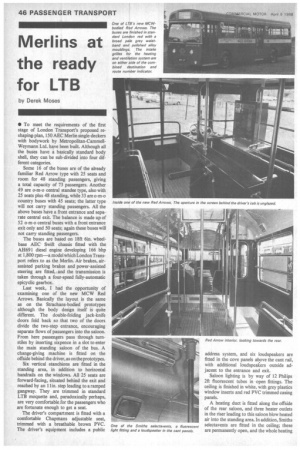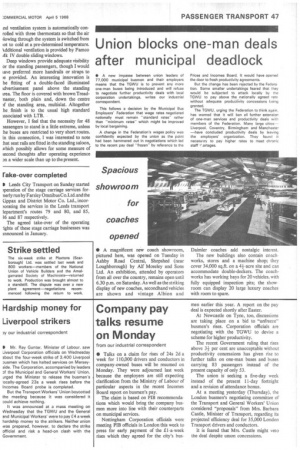Merlins at the ready for LT B
Page 48

Page 49

If you've noticed an error in this article please click here to report it so we can fix it.
by Derek Moses • To meet the requirements of the first stage of London Transport's proposed reshaping. plan, 150 AEC Merlin single-deckers with bodywork by Metropolitan-CammellWeymann Ltd. have been built. Although all the buses have a basically standard body shell, they can be sub-divided into four different categories.
Some 16 of the buses are of the already familiar Red Arrow type with 25 seats and room for 48 standing passengers, giving a total capacity of 73 passengers. Another 49 are o-m-o central standee type, also with 25 seats plus 48 standing, while 33 are o-m-o country buses with 45 seats; the latter type will not carry standing passengers. All the above buses have a front entrance and separate central exit. The balance is made up of 52 o-m-o central buses with a front entrance exit only and 50 seats; again these buses will not carry standing passengers.
The buses are based on 18ft 6in. wheelbase AEC Swift chassis fitted with the AH691 diesel engine developing 166 bhp at 1,800 rpm—a model which London Transport refers to as the Merlin. Air brakes, airassisted parking brakes and power-assisted steering are fifted,. and the transmission is taken through a four-speed fully-automatic epicyclic gearbox.
Last week, I had the opportunity of examining one of the new MCW Red Arrows. Basically the layout is the same as on the Strachans-bodied prototypes although the body design itself is quite different. The double-folding jack-knife doors fold back so that two of the doors divide the two-step entrance, encouraging separate flows of passengers into the saloon. From here passengers pass through turnstiles by inserting sixpence in a slot to enter the main standing saloon of the bus. A change-giving machine is fitted on the offside behind the driver, as on theprototypes.
Six vertical stanchions are fitted in the standing area, in addition to horizontal handrails on the windows. All 25 seats are forward-facing, situated behind the exit and reached by an 1 lin. step leading to a ramped gangway. They are trimmed in standard LTB moquette and, paradoxically perhaps, are very comfortable for the passengers who are fortunate enough to get a seat.
The driver's compartment is fitted with a comfortable Chapmans adjustable seat, trimmed with a breathable brown PVC. One of the Smiths selectavents, a fluorescent The driver's equipment includes a public light fitting and a loudspeaker in the cant panels.
address system, and six loudspeakers are fitted in the cove panels above the cant rail, with additional loudspeakers outside adjacent to the entrance and exit.
Saloon lighting is by way of 12 Philips 2ft fluorescent tubes in open fittings. The ceiling is finished in white, with grey plastics window inserts and red PVC trimmed casing panels.
A heating duct is fitted along the offside of the rear saloon, and three heater outlets in the riser leading to this saloon blow heated air into the standing area. In addition, Smiths selectavents are fitted in the ceiling; these are permanently open, and the whole heating hd ventilation system is automatically conrolled with three thermostats so that the air 'lowing through the system is switched from iot to cold at a pre-determined temperature. kcIditional ventilation is provided by Famco Ak IV double sliding windows.
Deep windows provide adequate visibility or the standing passengers, though I would Lave preferred more handrails or straps to re provided. An interesting innovation is he fitting of a double-faced illuminated Ldvertisement panel above the standing Lrea. The floor is covered with brown Treadnaster, both plain and, down the centre )f the standing area, multislat. Altogether he finish is to the usual high standard issociated with LTB. • However, I feel that the necessity for 48 )assengers to stand is a little extreme, unless he buses are restricted to very short routes. In this connection, I was interested to note hat seat rails are fitted in the standing saloon, which possibly allows for some measure of ;econd thoughts after operating experience xi a wider scale than up to the present.




























































































































































